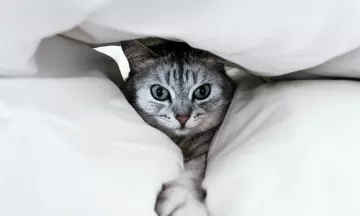The litter tray habits of our feline friends might seem strange, even mysterious - but a little understanding and care can go a long way to preventing even the smelliest problems! If you are a cat-sitter or owner on Pawshake, it’s important to know why and how to deal with unpredictable toilet behavior. The comfort of our beloved cats is worth it!

Here are some common loo issues that can arise in cats :
My cat’s litter tray is unbearably smelly – help!
First consider if this has always been the case, or if a stinky tray is a new development. If so, then it’s well worth taking your cat to the vet to make sure they aren’t sick – and consider what food you are feeding your cat as some commercial cat food or changes in diet can create a really smelly situation.
If your cat gets the all-clear from the vet, then it’s time to invest a bit of care in the upkeep of your cat’s litter box. Clean all solids out daily and replace the whole litter at least once a week (or even more regularly if you are using a non-clumping litter).
Clean the tray with a mild, unscented and non-toxic detergent and avoid air-fresheners and scented litter as this can be a big turn-off for a cat’s sensitive nose. A sprinkling of bi-carb soda on the floor of the tray can be a nifty way to absorb odour.
There’s litter being tracked all over the ground.
Some litters certainly ‘track’ (or spread around on the floor) more than others. As most of us know, cats don’t adore change - so while we might say to consider a different litter if this is an issue, do so very gradually by sprinkling the old litter on the new brand. If your cat is currently happily using their litter then a better idea might be to keep a handy dustpan and brush nearby to give the floor a quick cleanup whenever you scoop. If it ain’t broke, don’t fix it!
Some plastic litter liners might also make tracking worse if you have a really keen post-loo digger, so consider skipping the liner altogether. There are also many covered litter trays on the market too – but whilst some cats like the privacy, others might find the enclosed space (and smell!) a bit overwhelming.
My cat is going to the toilet outside the litter tray
If you notice any changes in your cat’s toilet habits, please speak with your vet as it’s important to find the underlying cause - which could be medical or behavioural. Either way, never punish your cat for having an accident. Despite the rumours, a cat isn’t trying to get revenge or be sly if you find a wee on the carpet! This is actually a result of something being out of balance in the world of the cat.
Some handy tips to help your cat use their litter –
- Every household should have one tray per cat, plus one extra.
- Each floor of a house should have a tray
- Place the tray somewhere private and clean, but where your cat has a clear view of household comings and goings.
- Avoid putting the tray near a noisy washing machine or heating appliance.
- As mentioned - scoop solids from the tray daily and scrub the tray at least weekly (with non-toxic, unscented cleaner diluted in hot water). Replace the litter at least weekly too.
- Whilst a clean tray is important, it’s equally important that a cat uses a litter tray out of habit because they can indeed smell their prior ‘business’. Therefore avoid scented cleaning products and air fresheners to mask the scent.
- Again – reconsider covered trays and liners if this makes access and usage a little easier, especially for an older cat.
- Start them young! Habits are formed during kittenhood, so a clean, well-placed tray will start things off on the right paw.
- If your cat has had an accident in an unusual spot, clean and dry it thoroughly and try to block access to prevent your cat returning. Close the door, or move furniture to cover the area.
I’m pet sitting and the cat under my care isn’t using their litter tray
If a cat you are sitting is suffering separation anxiety or is a bit nervous around strangers, this can be a common and understandable result. Speak with the owner beforehand about the possibility of this happening and have a plan of attack should the issue arise.
Getting to know your client’s cat before you begin pet sitting is essential during the meet and greet, and you might even consider a trial pet-sit to get to know each other even better.
Additional litter trays around the house are a good idea, as well as keeping bedroom doors closed (as a cat might urinate on their owner’s bed where their smell is strongest and most comforting). Any spots where accidents happen should be cleaned and access blocked with furniture or doors.
If you and the pet owner are concerned, a vet visit might be in order. Owners, always leave an emergency contact number of a family friend and of your preferred vet, just in case.
Have you had any experiences like the ones we’ve described while pet sitting? What did you do to combat it and put your feline friend at ease? Let us know in the comments or on our Facebook Page!




